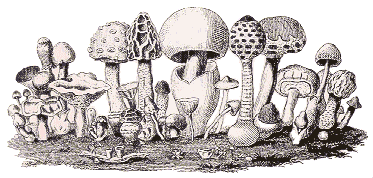
Monday 31st December 2012
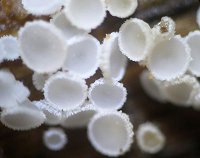
One last effort. I went to Stockton's Wood at Speke Hall. I had been there ten minutes and guess what? Yes. It poured with rain. There was not much there. All I had found was Lachnum virgineum (Snowy Disco) and the slime mould, Trichia scabra. So I ran for it and came home.
Happy New Year.
Sunday 30th December 2012
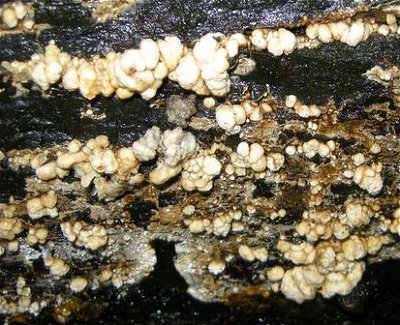
Just before Christmas I examined a beech tree that had snapped and fallen. I am glad I was not there when it happened as it fell across the footpath at a local nature reserve. All along the underside was a growth that I did not recognise. I took some samples which varied between jelly and more solid lumps. Even with the results from my microscope, I could not place it, although it looked familiar. While looking up some literature on another fungus, I found an article from The Mycologist about Nodulisporium cecidiogenes with a picture that looked just like my specimen. It grows with Coniophora puteana (Wet Rot). So I went back to check. After ten days, the growth had changed and was almost all jelly, like a Tremella. And it was growing on Coniophora. I did some more microscopy but the results were different from my first attempt. I then found a another article from Poland on the Internet with pictures of the spores that matched mine and I was also able to confirm spores from the Wet Rot. It seems that this fungus develops as it ages. Kew has a number of specimens in the Herbarium so I do not think it is rare, just under recorded. Not surprising having regard to the lack of literature.
Monday 24th December 2012
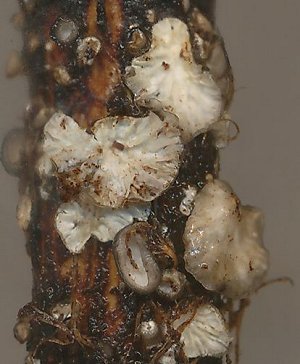
It rained again but I was so bored, I went out for a walk anyway. Local golf course again but as it was closed for play, I could visit parts without the danger of being hit by flying golf balls. Despite the weather, I found Clitocybe fragrans (Fragrant Funnel), Rhodocollybia butyracea (Butter Cap), a few Crepidotus and Myena species. In one corner of the site is a very tall Monkey Puzzle Tree (Araucaria araucana). A couple of the very long cones had fallen. One cone was attached to a piece of branch. On the branch was a fungus, an Oysterling type. Using Mycokey 4, I narrowed it down to species but It took me three gill sections and a lot of stains to find some identifiable spores. The result is Hohenbuehelia cyphelliformis. Never heard of it? Me neither. According to The National Database, not an unusual fungus. I bet nobody has found it on a Monkey Puzzle Tree.
Merry Christmas.
Sunday 23rd December 2012
It finally stopped raining after two days. I went up to my local golf course see if could find some jelly fungi as they tend to disappear when the weather is dry. The course was closed so I did not have to dodge flying golf balls. I only found one, Exidia glandulosa (Witches Butter). I also found Mycena leptocephala (Nitrous Bonnet) and Strobilurus tenacellus (Pinecone Cap) growing from a cone. First time I have found Strobilurus on this site. They were very small and I was hoping it might be one of the less common species but they grow on Spruce and never (so they say) on Pine.
Wednesday 19th December 2012
I have been trying to identify a bracket-like fungus growing on dead wood of a very old Yew tree. It covers a considerable area of the trunk. I have been cutting bits off it for nine months, trying to get a piece that would produce some spores. At last. Yesterday was the day. However, the fungus turned out to be Schizopora paradoxa (Split Porecrust). A common species but not on Yew, I can only find one other record in the National Database. Interestingly, this is the same Yew tree that grows Nectria coccinea, another very unusual species for this tree.
Sunday 16th December 2012
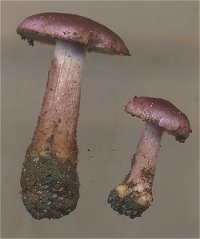
After two rainless days, I paid a visit to The Eric Hardy Nature Reserve in Liverpool. Named after a respected local naturalist, part of the reserve lies at the bottom of a valley with a steam running through. I had not visited for some months. Good job I took my wellies. It was a morass, well, over ankle deep and two large fallen trees did not help negotiation of the mud. A few bits and pieces. Mycena speirea (Bark Bonnet), Basidioradulum radula, Crepidotus cesatii (Oysterling) were common. One that fooled me was a small dark purple fungus that looked like a baby Lepista nuda (Wood Blewit) which is common at this time of year. Something about it (jizz) was different so I took it home. Under the microscope, the cystidia were encrusted, like little wigs. It was clearly an Inocybe and the only purplish one I know is variety lilacina (Lilac Fibrecap). But it does not look like a fibrecap as it has no umbo.
Saturday 15th December 2012
Cheshire Records Office found a mystery fungus at Delamere Forest and sent me a photo to see if I could identify it. It is so difficult to identify from photos unless they are very obvious. This was a white feathery specimen that could have been a Thelephora or Steccherinum. So they sent me a specimen in the post, in a plastic container. By the time it reached me it was a sloppy mess with pine needles attached. I had a look at it but could not even decide if it was fungal as it had numerous different types of spore from the accompanying vegetation. Impossible to tell what, if any, came from the specimen. I should have advised trying to dry it first as it is usually easier to rehydrate fungi, rather than take a chance on the Xmas post reaching me in time.
Wednesday 12th December 2012
I know that the temperature was zero and that the golf course was white with frost. But like mycologists, small things like this do not deter golfers. So we played. Here and there were small patches of ground that had been sheltered from the frost. In such a spot I found a collection of fungi with brown gills, smelling very mushroomy. I thought Agrocybe but the spore print was white. The conclusion is Clitocybe metachroa. No popular English name. Do not know why not as it is a common late season fungus.
Saturday 8th December 2012
A nice day so I decided to take a stroll round Speke Hall. Unfortunately, there was a Christmas Fayre and the place was packed, so I had to settle for the adjoining Stockton's Wood. This has recently been taken over by National Trust. This was a good wood for fungus but these days seems very depleted. A lot of the larger trees have long gone leaving mainly birch. There is no sign of replanting but lots of tidying up, so potential substrates, logs and twigs, have been removed. So I did not find much, only Cudoniella acicularis (Oak Pin) on the old oak stumps and a Laccaria laccata (Deceiver). At least it did not rain.
Thursday 6th December
It was cold today. I still had some bits and pieces being kept alive on wet tissue paper to see if they would develop. A fluffy pink cushion had developed into Chondrostereum purpurem (Silverleaf Fungus). The other piece of bark supported some Crepidotus versutus. This Oysterling is very small, my specimens were only 5mm, but it has larger spores than its similar brethren. Not common but probably not spotted due to its size.
Wednesday 28th November 2012
After a frosty start we played golf. A few survivors included Psathyrella candolleana (Pale Brittlestem), Mycena galopus var candida (White Milking Bonnet) and a Melanoleuca. I have recorded this as Melanoleuca polioleuca (Common Cavalier) from it's large size, colour and it has spindle shaped cystidia. However, trying to identify these very variable species is very difficult. Even the literature is confusing.
Saturday 24th November 2012
I have been puzzled by a small white Mycena growing on a yew tree, not only on the base but up to six feet on the tree. It has a basal disc which should make identification easier. The microscopic features would fit Mycena acscendens (Frosty Bonnet) but this has no recorded association with anything coniferous. But nor do any of the other bonnets with a basal disc. I took time off from building my ark to collect some more for further examination but this took me no further. While I was out I collected a couple of fruitbodies that I assumed were Flammulina velutipes. They were not in the best of condition as it has been so wet. When I looked at them at home, it was clear that I was wrong. It has a ginger brown spore print and cystidia with rounded heads. Putting the facts together led me to Pholiota tuberculosa, a first for me.
Monday 19th November 2012
I played golf. It did not rain. Not a lot about. A few Russula remnants and a Melanoleuca cognata (Spring Cavalier) in the new woodchip being put on the flowerbeds. I suspect it had appeared before the pile was spread as it was not actually growing in the substrate. I did find a new species for the site. Growing in the moss at the base of a birch tree was a small Mycena hiemalis. These are not easy to identify as there is another that looks just like it and the microscopic differences are few. The identification problem was made more difficult because I had collected four specimens from the same area of moss but three of them turned out to be very tiny Mycena filopes (Iodine Bonnet) again. It helped that the spore shapes are different and one smells of iodine.
Sunday 18th November 2012
This morning I visited a local wood at Childwall in Liverpool. Although only about a mile from home, I rarely visit it. It is a nice open beech wood with lots of mature and fallen trees but for some reason I find very little. A new Group member is a volunteer there and he has been compiling a list of species. He took me round at the beginning of October but, again we did not find much. I found a few today but just the usual Mycena filopes (Iodine Bonnet) and adscendens (Frosty |Bonnet) although the latter was on the bark of a yew tree, which is a little unusual. I sent him my list. He sent me his which included Terana caerulea (Cobalt Crust). Life is not fair.
Saturday 17th November 2012
More rain. Golf course closed. I managed to get out for a short walk and decided to take a look at one of the copses of Yew in my local park. I got very excited when I found lots of small white Mycenas and another smallish brown fungus with brown gills. However, when I looked at them under a microscope all the Mycenas were Mycena adscendens (Frosty Bonnet). The brown one was obviously an Inocybe with the distinctive cystidia (with little hats on). It was Inocybe lacera (Torn Fibrecap). I had hoped that they would be both something more unusual.
Thursday 15th November 2012
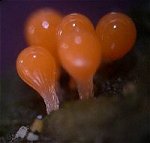
Nothing at my golf course yesterday even though it has been closed for two days due to the wet weather. I fared better today at my local course. Clavulina rugosa (Wrinkled Club) is a very common species. According to the British Checklist, it is rarely found under pine, which is where I found it today. However, the Swiss books say it is widespread in coniferous forests there. Another find was of a Myxomycete (Slime Mould). I do not study these. I have a colleague who does so I give them all to him. I am pretty sure that this one is Hemitrichia calyculata, growing on a rotting beech trunk.
Monday 12th November 2012
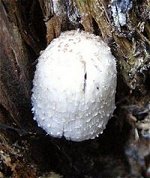
I have just finished examining the specimens I brought home on Saturday. An interesting find was of an Ink Cap that I saw when I looked down a hollowed out tree trunk. It made a good photograph. I thought it would be Coprinellus micaceus but there was something about it that persuaded me to take it home. When I looked at it under a microscope it was obvious that I was wrong. Nor did it fit any other common Ink Cap. I have at last tracked it down to Coprinopsis spelaiophila. Not one I know but it likes living in holes in trees.
Saturday 10th November 2012

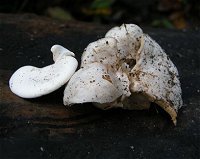
As the sun was shining, I went for a walk through the small wood at Hale. This is one of my favourite spots. Not very big but very old having been the site of Hale Hall since the 17th century. The Hall has gone but the woods remain. They always turn up something. Today I found a very large Volvariella gloiocephala (Stubble Rosegill) embedded in a pile of woodchip. I usually find this in ploughed fields. Most interesting was a find of Ossicaulis lignatilis (Mealy Oyster) growing from an old tree trunk that had snapped during a storm. This looks like a white Clitocybe but it grows on wood. I had never seen one until this year. This makes the second one. In order to properly identify this, it is necessary to examine the structure of the cap. I went cross-eyed trying to shave off an acceptable section.
Wednesday 7th November 2012
I had to pick up a prescription this morning. Crossing over the dual carriageway to the pharmacist's shop, I spotted Lactarius blennius in the grass. Then off to golf. Not a lot about at this time of year, although there is a very heavy leaf fall so I may have to wait until they clear before I can see what is growing. I did collect a new species for my course, Ampulloclitocybe clavipes (Club Foot). A fairly common fungus elsewhere, it is species 388 for this site. I have to thank my playing partner for hitting his ball into this particular spot.
Sunday 4th November 2012
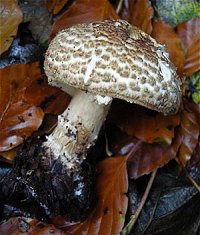
Had to miss the NWFG foray today. Did manage to get out later in the day for a quick walk round my local golf course. Not a lot to be seen. I did collect Cliotcybe vibecina (Mealy Funnel) and Phlebia rufa. I was very surprised to come across an Echinoderma asperum (Freckled Dapperling) in the undergrowth. This is said to be a southern species. I found some in a nearby park last year. This and other recent finds of 'southern' fungi suggests that things are warming up. Although it does not feel like it today.
Saturday 3rd November 2012
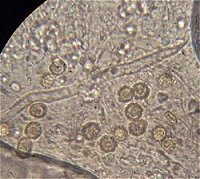
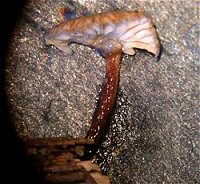
I managed to finish looking at all the specimens I brought home in boxes from our foray at Ainsdale last Sunday. Most of the specimens were fairly common. They just looked unfamiliar when collected. However, the last box of all (as usual) contained a piece of herbaceous stem with a tiny Agaric on the end. Tiny was only 4 mm. If the weather had been good enough for golf, I probably would have ignored it. I thought it was going to be a Marasmius (Parachute) until I looked at the spores which were round and spiny. It took me a day of research to narrow it sown to a Mycenella (Baby Bonnet?). Then I ran out of literature until I found a Polish key on the Internet. My conclusion is Mycenella margaritospora. I have informed Kew Herbarium but they may not want it as I only have 2 mm left. One of our more experienced colleagues has keyed out a Panaeolus reticulatus. This is not yet mentioned in the British Checklist but is well known in other European countries so there is no reason why it should not be here. Ainsdale always turns up something unusual.
Sunday 28th October 2012

My turn to lead a foray for North West Fungus Group. This time at Ainsdale Sand Hills Reserve. It poured with rain. It was windy. It was cold. I thought nobody would turn up but they did, all 16 of them. We had an excellent foray despite the weather. The Manager of the Reserve was very keen to see Tulostoma melanocyclum (Scaly Stalkball), one of highlights of this part of the Reserve. It has been missing recently but it does have a tendency to move around and is very difficult to find amongst the rabbit droppings. We accidently found some when one of the party dug one up thinking it was just a small puffball. We left a marker for the Manager to find it later. Another pleasing find was of Cordyceps ophioglossoides (Snaketongue Truffleclub). This had also been in decline but we found quite a few in its' usual site. 91 species recorded so far and lots still to come in from the other members of the team. (Photo from 2010 as it was too wet to get my camera out).
Friday 26th October 2012
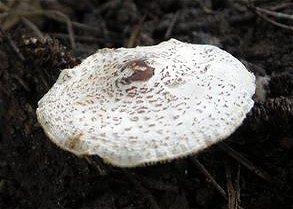
I went up to my local golf course to photograph a very nice Phlebia I had spotted last week. Unfortunately, it had deteriorated in that time, so I did not bother. However, on the ground beside the tree, I found the uncommon Dapperling, Lepiota felina. So all was not lost. I also found Melanoleauca cognata (Spring Cavalier). Despite the English name, it does grow in autumn. Interestingly, I found this in the same place in January this year. So this must be a second fruiting.
Thursday 25th October 2012
Our foray at Moore Nature Reserve with the Cheshire Group produced 105 species. A good haul. Today I got round to looking at my last three pots, all Inocybes. I am very pleased to say that I managed to identify them all as I. lacera (Tom Fibrecap), I cincinnata (Collared Fibrecap) and I. sindonia. Always difficult, I leave these to the last. I usually fail so I was very pleased to get three out of three.
Wednesday 24th October 2012
Went to my allotment to pick some lettuce and found Psilocybe cyanescens (Brownleg Brownie) and Mycena leptocephalus (Nitrous Bonnet) growing on site, probably from the wooden edging. This afternoon I was back to my golf course. Finds included another Boletus edulis (Penny Bun) but I missed it and another two, now sadly past their best, on Monday. Also collected were Tricholoma fulvum (Birch Knight) and Hygrophoropsis aurantiaca (False Chanterelle).
Tuesday 23rd October 2012
Went to look for more Boletus edulis (Penny Bun) at a site where they grew last year. No luck. Lots of other fungi about but nothing unusual. Some authors regard species growing under Oak as separate from those growing under Pine. This particular site is populated by a couple of large oak and a dozen pine trees. How would I know which tree they are associated with? Geoff Kibby regards a pale version growing under Birch as Boletus betulicola. On my golf course most of my collection is from a particular area of elderly birch. A couple of years ago, they planted some pine within a few yards. They are now about six feet high. On Monday, I found two specimens, one dark, one light, growing together immediately under one of the small pines. They were so close together it would seem logical to assume they are from the same mycelium. But which species of tree are they associated with? The new pines or the old birch?
Monday 22nd October 2012
Golf this morning. I found some more Boletus edulis (Penny Bun). Interestingly, two were under a newly planted pine tree although it is very close to the Birch area where I usually find them. The other one was under a Copper Beech, where there is not a Birch tree in sight. Today I played with a big hooker. Calm down. He hit his ball into places I had never been. As a result, I added a new species to my site list. Russula rosea (Rosy Brittlegill). Must play with him again.
Sunday 21st October 2012
I joined the Cheshire Group on a foray at Moore Nature Reserve, run by my friend Fungalpunk Dave. It was for beginners and had been advertised, so lots of people turned up. We did not expect the multitude of fungi that we found. Highlights so far are Tubaria dispersa on Hawthorn berries, Ossicaulus lignitalis (we think) found in the cavity of a Birch tree. This has caused me a problem because the identification depends on the microscopic structure of the cap cells. Not yet sure. More work to be done. Dave tells me we have identified 98 species so far. The list of finds will be on his website.
Friday 19th October 2012
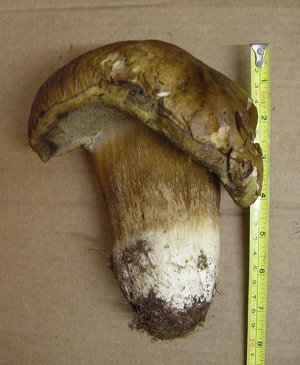
I had a golf match today. At one particular hole, I managed to clout my ball into some Birch trees. I usually do, as this where the Boletus edulis (Penny Bun) grow. I have not seen any on the course all year and we have eaten my dried collection. Oh joy! There it was growing in the usual place. And what a beauty it is, standing at nearly eight inches high. My opponents were a little surprised that I should be so happy playing golf in the trees but they know nothing. And we won the match. And it was warm and sunny.
Wednesday 17th October 2012
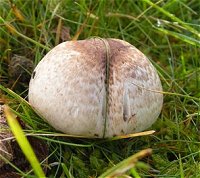
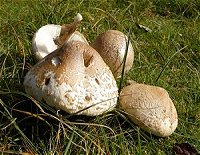
Golf course closed today so I decided to take a look at Raven Meols Reserve at Formby. I never got there. I parked in the official car park facing the sea, with the dunes in front of me. It is only a short walk to the frontal dunes. I started with the land between my car and the sea. In one hour I had collected so many I had to go back to my car to empty the boxes. I then looked at the pine woodland, immediately behind and that produced another couple of boxes. There were a few in the Poplar and Birch scrub. I then crossed over to the meadow grassland that leads to Squirrel Woods. It was alive with grassland fungi. After 3 hours I had so much I gave up and came home. I did not have to go much further than a few hundred yards from my car. I have still no idea what might be growing on Raven Meols Reserve, which is only a few yards south of where I parked. I managed to identify 36 species of which the highlights are Macrolepoita excoriata, Agaricus impudicus and Inocybe mixtilis. All of these are very uncommon but not many people foray on sand dunes.
Tuesday 16th October 2012
I was in one of my local parks yesterday. I found another Ink Cap growing on grass, just like the one I found at Speke Hall. As it was pouring with rain this morning, I decided to go and dig some up, find the sclerotia (tuber) and prove my previous identification of Coprinopsisd tuberosa. This is a very quiet park until I got there. There was one man and a dog who just would not leave. Then there was a school orienteering party. And the park keepers were out and about. Anyway, I quickly dug some up and took them home. I was not followed. No trace of a sclerotia. Nor would a herbivore have visited this park. So I started my research again and had to accept that my eyesight is so poor that I failed to recognise the perispore (frilly bit) on the spores, which are not as pronounced as shown in the literature. Once I had found these, my research led to Coprinopsis semitalis, which is a much better fit altogether.
Monday 15th October 2012
A bit confused today. In my local park is an Ink Cap that is just like the one I found at Speke Hall last week. They both grow on a grass lawn. The cap cells are unusual, round and spiny, which leaves me a choice of two. The key is that one has a 4 spored basidia, the other only 2. The problem is that the physical description, growing on grass, suggests it should be Coprinopsis saccharomyces (2 spore basidia). But, the microscopic examination says Coprinopsi tuberosa, (4 spore basidia). Mine are not on dung but the microscope says otherwise. And the spores are too small. This means that, tomorrow morning I shall sneak into the park and see if I can dig up a tuber.
Sunday 14th October 2012
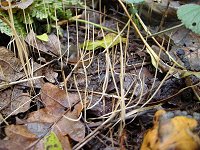
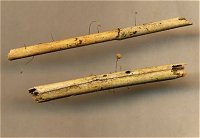
A foray at Rostherne Mere, the deepest natural lake in Cheshire. Unfortunately, it was flooded so we could not get to the best bits. Such is life. Still had a good day. Marasmius limosus on the dead reeds, a rarely recorded species. Macrotyphula juncea in great numbers in the mud around a fallen tree. Lots of smaller species. If this weather holds we could have a bumper season.
Saturday 13th October 2012

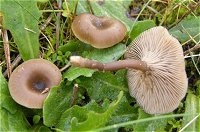
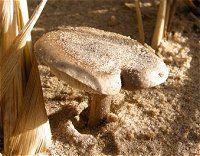
I had a meeting with the Rangers from the local Nature Reserves on the Sefton Coast. I had a look at Birkdale Hiills Reserve but it was overgrown with scrub and impassable. The Rangers have suggested the best site at Ravenmeols, so I shall pay a visit to see if we could add it to our foray sites. Although on the same stretch of the coast, it is surprising how different the sectors can be. I spent a couple of hours on the dunes at Ainsdale Hills LNR, looking for but failing to find the Sand Stinkhorn. I did find an egg but can not say which Phallus it was. I also found a number of sand specialists that we never see at Ainsdale Sandhills, which is next door. Agaricus devoniensis, Melanoleuca cinereifolia, Stropharia pseudocyanea and Clitocybe barbularum. They are described in the Checklists as 'not often recorded but apparently widespread'. I am not surprised as they take a bit of finding buried in sand and marram grass.
Friday 12th October 2012
I popped into Speke Hall this morning. I only had time to have a quick look round the Great Lawn before it poured with rain. I eventually had to run for it. On the way out I noticed some Ink Caps which I picked quickly but managed get a photo. The caps are 2.5cms high, which cuts the field down to 3 species: lagopus, saccharomyces and tuberosa. Then the cap cells are round with small warts, which cuts it down to 2 species. The basidia have four spores. The result is Coprinopsis tuberosa. I have not got the tuber bit, which could be fairly deep in the ground. I think The National Trust might object if I dug up their lawn. I can always go back tonight?
Wednesday 10th October 2012
Nothing much on my golf course today. Lots of Mycenas (Bonnets) and other small grassland fungi appearing, particuarly around the sand bunkers. As I was playing a competitive game, I did not have time to pick any. On my way home, I pass the local Council golf course, so I popped in to check one of my favourite spots under some pines. I saw a couple of Xerocomellus chrysenteron (Red Cracking Bolete), looking just like the photo in my book on Boletes. I also found Agaricus augustus (The Prince). It is a few years since I found this. A really good edible with lovely aroma. Unfortunately, this one had been kicked over.
Tuesday 9th October 2012
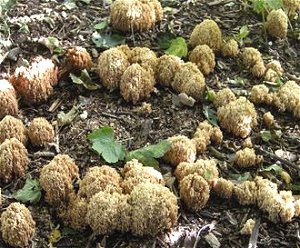
Now that Kew want my specimens of Daldinia fissa, I decided to go back yet again to collect a fruitbody still attached to the wood. At the entrance to the wood, there is a small paddock where they sometimes have a horse. Something caught my eye and so I went to investigate. It was a very large patch of Ramaria stricta (Upright Coral). I counted 36 large fruitbdies and there were numerous tiny ones. Should it be described as a 'reef' of coral fungi?
Monday 8th October 2012
Golf today. Not a lot around. I found a very nice Russula aeruginea (Green Brittlegill). Lovely colour. I also found Calocera viscosa (Yellow Stagshorn). I know it is very common but it is the first record of this species for my golf club. Kew Herbarium have asked for my specimens of Daldinia fissa on the burnt Oak. I may go back to see if I can get a specimen still attached to the wood. I must find a decent box to send it in.
Sunday 7th October 2012

I went back to Hale Woods. I found the Daldinia fissa. An Oak tree had been felled. The pruned branches were piled up alongside. The local yobbery had tried to set fire to these.The Daldinia fissa was growing there in some number, on the burnt parts. Interestingly, there appeared to be some new growth on the main trunk, which was not visibly burnt. I can find only one record in the National Database for this species on Oak. I collected some and a piece of the wood to send to Kew, if Kew wants it. The specimens are busy depositing spores in their box. Unlike Daldinia concentrica, fissa has a tiny stalk and if you cut one open it is jellylike inside, not concentric rings.
Saturday 6th October 2012
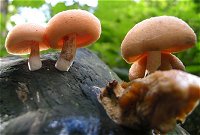
I paid a visit to the old woods that once surrounded Hale Hall on the banks of the Mersey. I checked to see if Rhodotus palmatus (Wrinkled Peach) had returned to a fallen tree. It had. Because everything is so overgrown, the path to this tree is now impassable. The Rhodotus has increased in number and size due to lack of disturbance. On the same tree grows Daldinia concentrica (Cramp Balls), so I assume it is Ash. The Daldinia is supporting an uncommon Nectria inventa. One that has me fooled is another Daldinia that I spotted on a fallen tree. I picked a couple. They both have stalks so not Daldinia concentrica. The only alternative I know is Daldinia fissa which favours Gorse and sometimes Birch. This tree was neither. I shall have to go back tomorrow and see if I can figure out what the tree is. Interestingly, the tree had been burnt. Perhaps Daldinia fissa just likes burnt trees??
Wedenesday 3rd October 2012
Nothing much on the golf course today. One of the Sycamore trees has been attacked by Pholiota squarrosa (Shaggy Scalycap), will probably have to be felled before it becomes a danger. More interesting was the discovery of Agaricus subperonatus, on the central reservation of a dual carriageway, as I was walking back from the local shops. They were so big, I thought someone had dropped something large from a car. It was previously known as A. vaporarius and I once found it pushing up through broken tarmac. Not the prettiest of fungi.
Tuesday 2nd October 2012
I had to take my car to the garage for a MOT. Walking home, in the torrential rain again, on the grass verge, clustered round a lamp post I found another group of Clitocybe rivulosa (Fools Funnel). That is twice in two days that I have found this species. Clustered round the next lamp post, I found a group of Hebeloma sinapizans (Bitter Poisonpie). You can usually tell this from the equally common Hebeloma crustiliniforme by cutting the stem in half to see that it has a cone feature at the cap apex.
Monday 1st October 2012
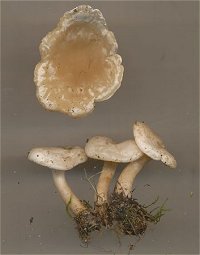
Suddenly, everything has taken off. I found out that the Lepiota boudieri (Girdled Dapperling), left by my allotment shed, was found under my neighbour's apple tree.
I played golf this morning, and found a few common fungi and also the deadly poisonous, Clitocybe rivulosa (Fools Funnel). Nice to see it is still in the same place.
I took time to check on the area in one of my local parks, where Geastrum striatum (Striate Earthstar) grows, and counted ten, an increase from last year.
I then finished off my finds from Ainsdale. A small yellow Mycena caused me problems. I eventually decided upon Mycena citrinomarginata. Said to be rarely reported. Probably because we would leave this one until the end. It is yellow but does not look like Mycena epipterygia. It was not one I knew but when I checked my old Ainsdale records, it had been found before by Ernest Emmett. So I am in good company.
Saturday 29th December 2012
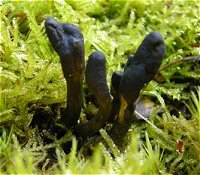
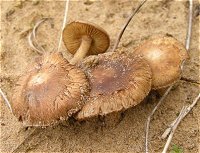
I led a public foray for the warden of Ainsdale Sand Dunes Nature Reserve. It was actually sunny and warm. We collected about thirty in a couple of hours. I have half a dozen still waiting for spore prints. Two highlights so far. Inocybe serotina, a sand dune specialist which is not often recorded. Cordyceps ophioglossoides (Snaketongue Truffleclub),which parasitizes a trufflle of the Elaphomyces genus. This was making a return after an absence of three years.
Friday 28th September 2012
Just finishing off yesterday's finds under the microscope. Inocybe rimosa (Split Fibrecap) with a very pointed cap was identified from the cystidia growing at the top of the stem. Another find was Lyophyllum loricatum. I identified this last year so it seems to be a permanent resident of my favourite shrubbery. It has a very cartiliganous cap that snaps audibly. Not one I have seen anywhere else. This shrubbery certainly throws up some unusual fungi.
Thursday 27th September 2012
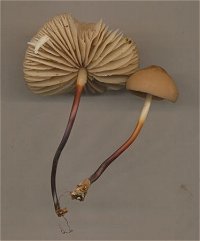
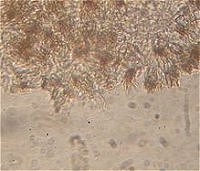
Just back from Berlin. I went for a walk round the Tiergarten. Nothing to be seen. It was very dry. Today, dodging the monsoon rains, I checked on my local park. I was surprised to find a lot of fungi. My favourite flowerbed was awash with Geastrum triplex (Collared Earthstar), hundreds of them. I then came across lots of Melanoleuca polioleuca (Common Cavalier) in another flowerbed. A nice group of Panellus stipticus (Bitter Oysterling) was followed by an excellent find of Marasmius cohaerens in a nettle bed. According to the books this is a fungus of south east England. Easy to identify because of it's unusual stem and branch-like cystidia.
Thursday 20th September 2012
As I am going to Berlin tomorrow, I went to my allotment to bed down the tomatoes while I am away. I happened to check on the adjoining plot to see if any more Hypholoma tuberosum had grown. None in the usual section. But then I spotted a fruit body growing on a different part of the plot. Oh joy! This suggests that the mycellium is spreading. I also found some fungi left by my shed by another allotmenteer who knows of my interest. I thought they were Inocybe until I checked the spores which were clearly Lepiota. The cap was brown and fibrous. I had to check the cap cells which contained crystals that dissolved in Ammonia. The conclusion is Lepiota boudieri (Girdled Dapperling). The things you have to do to identify these fungi. Trouble is I do not yet know where they were found.
Sunday 16th September 2012
A foray with fourteen colleagues at Moore Nature Reserve with North West Fungus Group. The fungi took a bit of finding as everywhere is still overgrown. We managed to find Lyophyllum connatum (White Domecap), Boletus edulis (Penny Bun) on the heath and the Waxcaps, Hygrocybe conica (Blackening), psittacina (Parrot) and irrigata (Slimy) in the meadow. A lot of small Galerinas that will have to be checked under the microscope but I did manage to identify the tiny Coprinopsis friesii that grows on dead grass stems. We also checked that Daldinia fissa was still growing on the burnt gorse branches. The fruiting bodies are getting smaller so I wonder how long it will remain.
Friday 14th September 2012
I recently found a Nectria on an old Taxus baccata. Not being proficient at this type of fungi, I asked a more expert colleague to look at it. He concluded that it was Nectria coccinea. Not an unusual fungus but there are only three records for this growing on Taxus in the National Database. So an interesting find.
Tuesday 11th September 2012

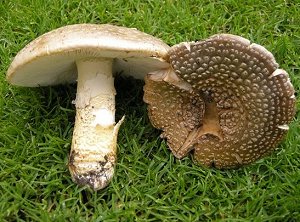
Driving along a local dual carriageway in Liverpool, I had noticed some fungi on the central reservation. Dodging the showers, I went back to see what they were. I was very surprised to find, under an Oak, a number of Boletus radicans (Rooting Bolete), a species I had never seen before. Beside them were a couple of Amanita franchetii, a species I found for the first time last year on another central reservation. The literature describes both these species as being common in southern England but unusual for the north. I am not certain where the 'Liverpool Riviera' lies for the purposes of fungal geography. These species may have been here for years without being noticed but having regard to recent finds of other southern species here and in Manchester, it does suggest that our north west climate is becoming more attractive to such fungi.
Saturday 8th Septmber 2012
I joined a group from the Merseyside Naturalists who have recently taken an interest in fungi. We went to Freshfield Dune Heath and Ainsdale Woods. It was very hot and dry. Not many finds but we did collect some Boletus edulis (Penny Bun), sadly past their best save one. Had it for breakfast. Chroogomphus rutilus (Copper Spike), Suillus granulatus (Weeping Bolete) and Panellus stipticus (Bitter Oysterling), the last being the first record for this fungus for this site. I was also able to identify the rust fungus Puccinia obscura on Lazula. One of the benefits of foraying with a mixed group of naturalists is their ability to identify plants of which I have little knowledge.
Thursday 6th September 2012
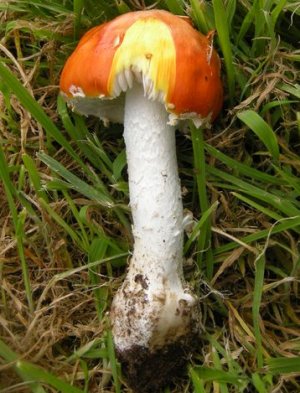
I took a day of from golf and gardening to visit Arley Hall in Cheshire. Beautiful Gardens and woodland walks. Not much fungi around as it is a little too well maintained. I found a nice Fistulina hepatica (Beefsteak Fungus) on an oak stump and a few Russula atropurpurea (Purple Brittlegill). I was on my way out when I noticed an Amanita under a Birch. It was orange yellow but had no spots. It was very fresh as it had not fully opened out. It had not been raining recently so it was unlikely that they had washed off. There is an Amanita muscaria var aureola for which there is one record on the National Database. A check on Google Images produced a number of photos and my specimen fits perfectly. I have contacted Kew to see if they want it.
Sunday 2nd September 2012
A good day at Carr Mill today. Being in the woods, we avoided the rain. I recorded 45 species on site and most of those attending have various boxes to examine at home. Very interesting was Lanzia echinophila, a small brown disco, found on the old husks of a sweet chestnut, its usual host. More interesting was the same fungus on the husks of Turkey Oak. Another excellent find was of Lactarius obscuratus (Alder Milkcap), a milkcap that is particular to Alder in boggy areas. I have only seen it once before, at Jodrell Bank a few years ago. This a difficult species to identify as there are two almost identical species that can only be separated by spore size.
Saturday 1st September 2012
I made a short excursion at my allotment site to see if there were any Tubaria dispersa growing. This fungus is usually associated with Hawthorn berries. It will also grow with Cotoneaster berries. There it was for the fifth year running under a bush that hangs over the fence. If you have a Cotoneaster in your garden then it is worth having a look for it. I find that it likes bare soil under older trees and bushes.
Monday 2nd January 2012
I was forced to miss the New Years Day foray at Ainsdale so made up for it by a visit to Speke Hall. It was Monday. It was shut. I found a hole in the fence and finished up down a path I have never been on before. Mature trees. Lots of dead branches and twigs and needles. A few finds. I was lucky to spot a tiny Mycena adscendens (Frosty Bonnet). Also Mycena filopes (Iodine Bonnet) and Postia stiptica (Bitter Bracket) on a dead log. The path ended at the entrance to The Hall where I found a group of Tricholoma terreum (Grey Knight) that had survived the light frost on the grass verge under some beeches.
Friday 6th January 2012
Nothing much on the golf course. This afternoon I had to drive along the riverside promenade where there are lots of shrubberies. Managed to find Agaricus silvaticus (Blushing Wood Mushroom) and Melanoleuca polioleuca (Common Cavalier) buried deep in the woodchip. Probabaly hiding from the recent gales.
Saturday 7th January 2012
When I was out the other day I found what turned out to be a Myxomycete (Slime Mold) growing through the spines of a Sweet Chestnut husk. I did not have many so I went back to see if I could find some more. No luck. After the gales the site was deep in blown leaves. It seems to be a rule of mycology that you have to pick them first time as you never find them again. I did find a group of Gymnopilus junonius (Spectacular Rustgill) and some Crepidotus cesatii (Oysterling). Also on the Great Lawn at Speke Hall were a lot of Hygrocybe psittacina (Parrot Waxcap) and Galerina clavata. Crossing a field to get back to my car, I found a different Galerina in the long grass. Still working on it.
Sunday 8th January 2012
Rain today so I worked on the Galerinas using various books and keys. I had actually found three different species. The spores were different sizes and the cystidia varied in that some had long necks with a round head. My conclusions were Galerina clavata, (very large spores), G. pumila (Dwarf Bell) and G. vittiformis (Hairy Leg Bell). It took me all of the morning.
Wednesday 11th January 2012
Still plenty of fungi on the golf course, some clearly new growth. Found Peziza cerea (Cellar Cup) growing from pieces of wood debris in a flowerbed. Not easy to sort this species out from similar varieties. A branch that had fallen from an Oak tree was displaying lots of Peniophora quercina (Oak Crust?) and Vuilleminia comedens (Waxy Crust).
Thursday 12th January 2012
Threat of frost tomorrow so I went over to the area where I found Geastrum striatum (Striate Earthstar) four years ago. They are still there. A new fruiting body was showing. Also collected were Crepidotus versutus, Tremella foliacea (Leafy Brain) and Polyporus brumalis (Winter Polypore).
Monday 16th January 2012
Cold but sunny so worth a walk. Had a look under some logs and branches. Always good for something at this time of year. I found Fuscoporia feruginosa (Rusty Porecrust), Phlebia radiata (Wrinkled Crust), Datronia molluis (Common Mazegill) and Diatrype stigma (Common Tarcrust). Nothing unusual but this is only the beginning of winter.
Tuesday 17th January 2012
Today was very cold but dry. Just the weather to have a bonfire and to dispose of the prunings from the fruit trees and bushes. These have been piled up in a heap for a couple of months. Having reached the bottom of the pile, amongst the dead leaves and branches I spotted a couple of interesting specimens. One was obviously a Myxomycetes (Slime Mould) probably a Didymium (white crystals and a stalk). The other looked like a Hypoxylon. But when I got it home and looked at the spores, it was clearly another Slime Mould. No idea what it is. I am not very proficient at these.
Sunday 22nd January 2012
Passing the old orchard, I noticed that some of the pruned branches that had been piled up were displaying a fungus that was spreading out across the bark. I took it home and looked at it under my microscope. It was Cylindrobasidium laeve, which is common but this is the time of year to find this type of fungi.
Monday 23rd January 2012
A lovely morning in Liverpool so I played golf. I was surprised to find Coprinopsis atramentaria (Common Inkcap) so early. An interesting fungus which, if you eat it and drink alcohol it makes you sick. It is therefore used as a cure for alcoholism.
Tuesday 24th January 2012
It rained all night and this morning so I went for a walk to see if I could find some Exidias or Tremellas which come to life in wet weather. I was lucky to find Exidia thuretiana (White Brain). The most common local Exidia is nucleata, which has tiny crystals inside the body. This did not and the larger size of the spores was an additional clue. Also plentiful was Byssomerulius corium (Netted Crust) that was growing on every piece of a pile of branches. Most surprising was a Melanoleuca cognata, identified from the nettle sting cystidia and large spores. Is it spring? I think that this warm weather following last week's frost has confused it.
Thursday 26th January 2012
Nice day for golf. Surprised to find some yellow-brown Oyster Mushrooms growing from a tree root that had been damaged and exposed by the grass mowers. I thought Pleurotus ostreatus (Oyster Mushroom) but the gills ran down the stem, which ostreatus does not have. I could not have identified this without my microscope. The spores were too large for ostreatus, between 11.2 and 12.8um. The conclusion is Pleurotus dryinus (Veiled Oyster) although I could not find any aleuriospores. This is a parasite on tree wounds so that also fits. The likely tree was a Populus tremula (Aspen).
Saturday 11th February 2012
Although it is bitterly cold, the Liverpool Riviera has been free of snow, so golfing has continued. Nothing growing on the ground but I did spot a Laetiporus sulphureus (Chicken of the Woods) growing low down from a cherry tree. I had not spotted it before the surrounding plants had died down. I keep seeing other fungi on trees but they are frustratingly too high to reach. People tend to look at you funnily when you are jumping up and down hitting branches with a stick.
Tuesday 14th February 2012
When the weather turns cold, all the golf club and parks staff start cutting down branches and tidying up all the fallen branches and twigs. This is only because it is too cold for any other work and they have to kept occupied. Today, I discovered that they had removed my favourite pile of tree waste. Ah, the memories. I did find a bracket growing from a wound in a beech tree. The spores and cystidia tell me it is Oxyporus - populinus (poplar Bracket), I thought. Alas, my books tell me there are four Oxyporus it could be and I do not have the necessary literature to make a final identification.
Friday 17th February 2012
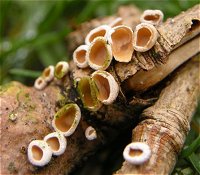
Taking advantage of a short spell of warmer weather, I took a stroll around Speke Hall. After the recent severe cold, I was surprised to find Clitocybe fragrans (Fragrant Funnel) growing on the Main Lawn. In the woods, I also came across Crepidotus cesatii (Oysterling) and a couple of yet unidentified, tiny Mycenas (Bonnets). Star of the day was a large collection of Schizophyllum amplum on a pile of thin branches and twigs. I thought they were more Oysterlings at first but they do not have gills and look like a tiny Auricularia (Jelly Ear).
Friday 24th February 2012
I took a walk in our local nature reserve and was disappointed to find that it looked like a tank had passed through (and a few scramble bikes). As most of the plantings are no more than fifteen years old, I was surprised to find Inonotus radiatus on such young alder trees. There was a lot of fallen wood from the mature trees which was very productive. I identified Phanerochaete sordida and velutina, Penniophora cinerea and quercina and Cylindrobasidium laeve. Nothing unusual but they have to be identified which requires a bit of microscopy.
Monday 27th February 2012
Weather still fine so I went for a wander round the woods that surrounded the now demolished Hale Hall. Mostly Corticiaceae on dead wood, such as Coniophora puteana (Wet Rot), Radulomyces confluems and molaris, Trechispora farinacea. It can be a struggle to identify these fairly common fungi as you need to find all the microscopic features before you can be sure. I did manage to find a Mycena arcangeliana (Angels's Bonnet) hidden under a trunk and lots of Exidiaglandulosa (Witches Butter). This also turned up at my golf course the following day.
Saturday 3rd March 2012
It was the North West Fungus Group AGM at Risley Moss Reserve near Warrington. Prof. Bruce Ing, our President, kindly traveled from Scotland to give us a talk about fungi near his new home. We then went for a ramble around the Reserve. We found numerous Sarcoscypha austriaca (Scarlet Elfcup) and Polyporus brumalis (Winter Polypore). Most of the other finds were Corticioid (Crust Fungi) from under logs but we did come across a very shy Mycena speirea (Bark Bonnet) hiding in a pile of stacked wood. Interestingly some of the Scarlet Elfcups had long stems where they had been forced to grow from under the woodpiles.
Sunday 11th March 2012
The North West fungi Group held a foray at Duxbury Woods near Chorley in Lancashire. A nice day but the underfoot conditions were exceedingly boggy. Not much in the way of gilled fungi, a Hemimycena tortuosa being a good find. Most of our collections were of crust fungi from the wealth of dead trees and fallen branches. Subulicystidium longisporum caused me some identification problems but one of my colleagues resolved it. Also found were Coniophora arida (Wet Rot), Lyomyces sambuci (Elder Whitewash), Resinicum bicolor and Hyphodontia alutaria. Most interesting was a Ganoderma species (Bracket) on pine, a most unusual host. This is now to be sent to Kew Herbarium for final identification. Kew also want my Schizophyllum amplum so I can now send a decent parcel of specimens.
Saturday 17th March 2012
After digging my allotment all morning, I went for a short walk to unravel the muscles in my back. It has been very dry here. All I could see was Kretzschmaria deusta (Brittle Cinder) on a fallen Birch tree. This species was everywhere when we went to Duxbury on Sunday. Although common, it is the first time I have recorded it for this part of Liverpool. Must be the weather.
Monday 19th March 2012
At last it has rained - for two days. So I went for a walk in the park to visit my favourite flowerbed. My luck was in. I found Leratiomyces ceres (Redlead Roundhead). Also Melanoleuca cognata (Spring Cavalier) which you would expect at this time of year. The third find was an Agaricus under Cupressus. I thought it would be Agaricus silvaticus but it did not turn red when cut, only slightly pinkish. It also had large spores. The nearest I can get is Agaricus lanipes which is said to be rare. This has to grow somewhere and in view of the rarities this flowerbed has produced so far there is no reason why it should not grow here.
Tuesday 20th March 2012
In a small patch of soil in the car park of my golf club I found a group of Peziza badia (Bay Cup). Easily identified because the spores have a strong reticulate patter. Interstingly, for the past two years, this exact spot has produced groups of Peziza cerea (Cellar Cup) although these were more adjacent to the concrete path, two feet away. As P. cerea has smooth spores it is not possible to mistake the difference. I wonder what the attraction is for Pezizas.
Wednesday 21st March 2012
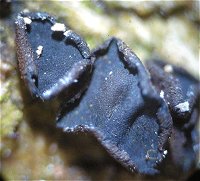
When I visited Speke Hall recently, I found a very tiny Ascomycete on a dead gorse bush. I was not confident of my identification. Fortunately, I have a colleague in Oban who is good at these so I duly sent it to him. He confirmed my conclusion - Phaeangella ulicis. There are only 31 previous records in the National Database. Mind, it is only 0.5mm big and I was just lucky to spot it as I was cutting out a Peniophora at the time. This may explain it's rarity.
Thursday 22nd March 2012
I went back to Speke Hall to get some more specimens of Phaeangella ulicis from the gorse bush for my colleague in Oban who identified it for me. Managed to find a few more interesting specimens. Peniophora incarnata (Rosy Crust) on the same gorse bush. On a fallen oak branch I found Bulbillomyces farinosus, lots of little white spheres. I have a few more crust fungi that I cannot identify. I did find a very early group of Psathyrella candolleana (Pale Brittlestem) in the birch wood.
Wedenesday 28th March 2012
Remember that last week I reported finding Peziza badia at my golf course. This week the Peziza cerea has returned to the same spot I found it last year, directly abutting a concrete paved path. I identified it from the large plain spores. The Peziza badia are still there, only a couple of feet away. We need some rain.
Thursday 5th April 2012
On a recent visit to Speke Hall, I found a tiny dark brown cup shaped Ascomycete on a dead gorse branch. A more informed colleague suggested that it was a Phaeangella but I was instructed to get more specimens as the one I sent was not very mature. So I did. It turned out to be Ionomidotis fulvotingens. No? Me neither. It is not in any of my reference books. It seems the more I learn the less I know. I am very grateful to be able to call on such experts to help me out.
Sunday 15th April 2012
I went to Ainsdale Sand Dunes Nature Reserve to check on routes and paths before I lead a foray next week. It was very dry. Even the slacks that held a little water last year have dried out completely. I did not find much. I counted 12 Morchella elata (Black Morel) on the inner dunes but they were much smaller than last year and might not last until next Sunday. I was more concerned with planning my route than foraying so, hopefully, more eyes might turn up some species. This is usually a good site at any time of year. A foray on New Years day produced some excellent specimens.
Tuesday 17th April 2012
Golf this morning. Hiding in a patch of nettles I found a small group of Calocybe gambosa (St. Georges Mushroom). First of the year. Unfortunately my golf ball was also in the nettles.
Sunday 22nd April 2012
I led my foray to Freshfield Dune Heath and Ainsdale Sand Dunes Reserves. Even after a week of rain, it was still very dry. The warden joined us and said that the water level was the lowest it has ever been. The heath produced some interesting Ascomycetes to be researched, as well as the usual Dasycysphus, Mollisia and Bisporella species. Out on the dune slacks, the Morcella elata (Black Morel) had survived the week. We also located the rare local speciality, Clitocybe vermicularis. Another interesting find was Monilinia johnsonii that grows on buried hawthorn berries. This tiny cup fungus one has to search for and is probably more common than records suggest.
Thursday 26th April 2012
On my recent foray to Freshfield Dune Heath, we found a small brown cup fungus on dead Cytisus (Broom), although it might have been Salix (Willow). I sent it to my friend in Oban, who knows more about these then I do. It turned out to be another Ionomidotis fulvotingens. The same fungus I found on Ulex (Gorse) at Speke Hall. You wait for years and two come along together.
Tuesday 15th May 2012
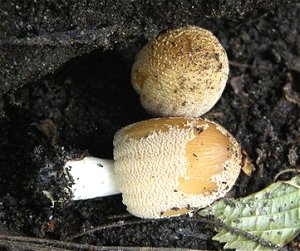
I have just returned from a holiday in Greece where the only fungi I had were for breakfast. So I took a quick trip around my local parks today. My, hasn't it grown? It was difficult to find anything in the lush undergrowth. The unmistakable perfume of Clitocybe fragrans (Fragrant Funnel) was the first find, followed by Agrocybe praecox (Spring Fieldcap) in the woodchip. An interesting find was Coprinellus domesticus (Firerug Inkcap) which looks similar to Coprinellus micaceus (Glistening InkCap). The difference is in the veil which has to be examined under a microscope. Coprinellus domesticus has elongated cells in the veil which are not present in Coprinellus micaceus. Still have two Agaricus to work on.
Tuesday 22nd May 2012
Back to golf after my holiday. Nothing much showing yet other than a few Coprinus micaceus (Glistening Inkcap), a very common spring fungus.
Friday 1st June 2012
A couple of weeks ago I was pruning my loganberry bush. On a dead piece of thick stem, I found some Hyphodontia sambuci (Elder Whitewash). Looking more closely, I could see some very tiny round fruitbodies within the Hyphodontia. Fortunately, I have a colleague who delights in examining Ascomycetes. He identified it as Nectria mammoidea. Checking my copy of Ellis & Ellis I noted that a variety of this species, var. rubi, grows at the junction between stem and root of Rubus which is exactly where it was found.
Monday 4th June 2012
As I was walking into my golf club I saw a group of smallish brown fungi in the woodchip by the entrance. With pink gills, I assumed they would be Entolomas. However, when I checked them under my microscope, the spores were round, not angled. Pluteus, probably P. cervinus, as there are the remains of a cherry tree in that spot. When I looked at the gill edge, there were no cystidia with horns, just large inflated ones. The eventual conlusion is Pluteus nanus (Dwarf Shield), a first for the site.
Tuesday 5th June 2012As it has rained recently, I visited my favourite flowerbed at my local park. It did not disappoint. Coprinopsis lagopus (Haresfoot Inkcap), parasola leiocephala on woodchip, Agrocybe praecox (Spring Fieldcap) and Conocybe aporos (Conecap). Nothing unusual bit it is encouraging to see something growing.
Monday 11th June 2012
I went to look at my favourite woodchipped flowerbed at Calderstones Park in Liverpool. It was covered with Agrocybe. I picked a few that looked different but my initial thought was Agrocybe praecox (Spring Fieldcap). I put some on slides for spore prints and confirmed my identification with spores averaging at 9.6um. But one produced spores up to 12.6um, too large for praecox. So I checked the cystidia and one had inflated cystidia which again confirmed praecox. The larger spored specimen had utiform cystidia. None of my 10 specimens had a ring nor did any of my photos on site. My conclusion is Agrocybe putaminum. My only decent references are an article by Elsa Vellinga on the Internet and a French site Bas de donees Mycologique. If you see any large Agrocybe on woodchip, they are worth checking. You never know.
Tuesday 12th June 2012
Golf today and fungi are starting to appear. A nice collection of Agrocybe pediades (Common Fieldcap) growing on the top of a sand bunker. Also Agrocybe praecox (Spring Fieldcap) and Bolbitius titubans (Yellow Fieldcap) growing on the woodchip in a shrubbery.
Wednesday 13th June 2012
I went back to my local park to collect a few more Agrocybes in order to check my original finding of Agrocybe putaminum. I found some more but also Agrocybe molesta (Bearded Fieldcap) which has much larger spores, as well as the usual Agrocybe praecox (Spring Fieldcap). Also in the flower beds were Lacrymaria lacrymabunda (Weeping Widow). On a fallen Beech I noticed a purple fungus which turned out to be Panus conchatus (Lilac Oysterling), a new one for the site. Stars of the day were a group of 25 Melanoleuca verrucipes (Warty Cavalier) growing under a Rhododendron bush. These are supposed to be rare in the North but this is the second year they have appeared and this time in good numbers.
Sunday 17th June 2012
I held a fungi foray for Merseyside BioBank who were holding a bioblitz. It was very successful. The event was held at Court Hey Park in Liverpool which is also the home of the National Wildflower Centre. I went on Friday, in torrential rain, to plan my route as I had not been to this site before. It did not look very promising. However, on the day, with more eyes, we found 40 species. Most interesting was a powdery mildew on a Vipers Bugloss in the Wildflower Centre, which is not in my books. The other was Schizophyllum commune on a fallen Beech tree. This is not a northern fungus. It is very unusual find for this area. My audience had a few people who only wanted to know about edible fungi so I was so pleased when the last discovery was a group of Agaricus xanthodermus that turned a beautiful chrome yellow. That silenced them.
Monday 18th June 2012
Golf today in North Wales at Padeswood. I have records from this golf course from many years ago. Today I found nothing until the last hole when I found some Agaricus xanthodermus (Yellow Stainer) under some Cupressus leylandii.
Thursday 21st June 2012
A small white Mycena found on a Yew tree on Sunday has been identified as Mycena clavularis. An unusual find as there are only two records in the National Database on Yew. Hoping to collect some for Kew Herbarium, I went back to The National Wildflower Centre to get some more. Unfortunately, heavy overnight rain had washed them all away. I shall now have to wait until they grow again. The staff at Merseysdie BioBank are keeping watch and will keep me informed.
Sunday 24th June 2012
At last the rain stopped so I was able to go for a walk to the local Council golf course. The stumps and fallen wood were showing quite a few species. Crepidotus mollis (Peeling Oysterling) had taken over one section of woodland. I had never before recorded it on this site. There were a couple of different tiny white Mycenas. One was Mycena adscendens (Frosty Bonnet), it has a basal disc and very warty cystidia. The other one, I identified as Mycena olida (Rancid Bonnet) from the type of hyphae in the cap. Always difficult these because the differnce between species, like the fruitbodies, is very small.
Monday 25th June 2012
I played golf this morning. The rain had brought quite a few fungi out. Melanoleuca polioleuca (Common Cavalier), Suillus grevillei (Larch Bolete), Agaricus arvensis (Horse Mushroom) and xanthodermus (Yellow Stainer). I was surprised to find Calocybe gambosa (St Georges Mushroom) still growing as I recorded this over two months ago in April.
Monday 2nd July 2012
I spent the weekend at a British Mycological Society Group Leaders Meeting at Hereford, where we discussed matters relating to recording, databases, forays etc. After two days of sitting down, I was pleased to go for a walk, once it had stopped raining. I was amazed at the amount of Auricularia auricula-judae (Jelly Ear) that had appeared after the rain. This was, until recently, popularly known as Jew's Ear or Judas's Ear (Judas having allegedly hanged himself from an Elder tree, this being the usual host for the fungus). The scientific name still remains as auricula-judae. Growing amongst them on a fallen Beech I noticed two small fruibodies that I thought were young ones until I realised that they were a different colour. They were Pezizas. After rigorous examination under a microscope I concluded that they were Peziza micropus, which like rotten Beech trees.
Friday 6th July 2012
Dodging the rain this week, trying to harvest my soft fruit before it rots. Under my raspberries, I noticed a group of Psathyrella candolleana (Pale Brittlestem), probably attached to some wooden edging. Then off to golf, which lasted 30 minutes before torrential rain set in. On my way back to the clubhouse, I came across a couple of small Calvatia gigantea (Giant Puffball). It is the third year they have grown in the same spot. One of the woodchip beds in the car park was covered with Tubaria conspersa (Felted Twiglet), very tiny specimens but the white veil remnants on the cap were very clear. Although said to be common, it is the first time I have recorded it. Perhaps I do not spot it because of its size.
Sunday 8th July 2012
After the heavy rain of last week, we managed to get two sunny, blue sky days. I went for a walk round my local park which looked very bedraggled. The grass and weeds have now grown so high it is impossible to find any fungi on the ground. Some of my favourite spots are overgrown and almost inaccessible. A couple of Calvatia gigantea (Giant Polypore) in the car park and Polyporus squamosus (Dryads Saddle) on an old tree trunk were all I could find after two hours.
Monday 9th July 2012
Liverpool has lots of tree-lined dual carriageways that are a rich source for fungi. I had to collect a medical prescription this morning. Rather than wait in the pharmacist's shop for 10 minutes, I went for a walk along the road. Amongst the grass under the Beech trees, I found Laccaria laccata (The Deceiver) and Inocybe flocculosa (Fleecy Fibrecap). Not bad for a few minutes on a main road.
Saturday 14th July 2012
All this rain seems to have adversely affected the fungi at the moment, although it has been warm today so hopefully they will take advantage and show themselves before the next deluge promised for next week. The damp conditions did bring out lots of the slime mould, Mucilago crustacea, which covered quite large patches of a grass path at my allotment.
Sunday 15th July 2012
We held a North West Fungus Group foray today, at Etherow Country Park on the outskirts of Manchester. At least we got a fine day. There were a few gilled fungi about, Mycena acicula (Orange Bonnet), Mycena rorida (Dripping Bonnet), Russula versicolor (Variable Brittlegil) but most of our finds were of Ascomycetes. Neottiella rutilans was the largest, most of the others being microfungi on various twigs and dead bits. Most interesting were the number found on the dead stems of Impatiens glandulifera (Himalayan Balsam). At least this plant has some uses although most of the species were so small, I had to put them under a microscope to see them in any detail.
Wednesday 18th July 2012
Golf today. Blue skies. We actually got all the way round without getting wet. I managed to find one Leccinum roseofractum, a pink fleshed Birch Bolete. A fellow golfer told me he had seen dozens of fungi in the trees but, as I told him with an air of disdain, I did not hit my ball into the trees. On my way home, I popped into a local park, mainly of beech trees. I managed to find a green coloured Russula cyanoxantha (Charcoal Burner) and a lot of Laccaria amethystina (Amethyst Deceiver) but not much else of note.
Thursday 19th July 2012
The rain has returned. I looked at the tiny Ascomycetes growing on Himalayan Balsam that I had brought back from Etherow. I managed to identify Hymenoscyphus repandus and Hymenoscyphus scutula, which has much longer spores. I have now discovered that someone found the truffle, Melanogaster broomieanus, during the foray. I never got to see it. I am very disappointed.
Thursday 26th July 2012
The weather has now turned hot. The golf course has quickly gone hard so not much around. My only find was a large Polyporus squamosus (Dryad's Salad) growing from buried wood. To keep obstructions to a minimum, stumps of cut down trees are usually ground down, so it can be tricky to determine whether a fungus is growing on wood or soil. Now is the time to start looking for rusts and mildews. I usually have trouble identifying the plants which makes it difficult for me to then identify the species of rust. Found a mildew on Hawthorn, so I should be able to identify it.
Saturday 28th July 2012
I am having a new kitchen fitted. To escape the misery, I went for a short stroll in my nearest park. I managed to find a group of Russula parazurea (powdery Brittlegill) under beech and some Agaricus silvicola (Wood Mushroom) in the shrubbery under Italian Cypress. Then I had to run for it as the heavens opened yet again. I picked one on woodchip that I did not know but have not yet found any spores. It looks to have some sort of infection. There seems to be something in this particular section of shrubbery that affects fungi. This is not the first specimen I have found there that appears to have something wrong with it and which fails to produce the necessary microscopic information.
Sunday 29th July 2012
The rain was torrential last night. My back garden was under water. Fortunately, the sun came out after lunch, so, bored with rowing and swimming, I went to my local golf course for a breath of fresh air. Finds were good. Boletus erythropus (Scarletina Bolete) and Lactarius subdulcis (Mild Milkcap) aptly named, under a beech tree. Hundreds of Marasmius rotula (Collared Parachute) everywhere. Russula atropurpurea (Purple Brittlegill) under Holm Oak. I also identified Xerocomellus chrysenteron (Red Cracking Bolete) under Pine. This genus is difficult to identify as they all look very similar. Chrysenteron is now said to be uncommon. However, when you cut it in half the flesh in the stem is a deep red all the way down. A good find. Another difficult identification was of Inocybe napipes (Bulbous Fibrecap) under beech, so named because of the small bulb at the bottom of the stem.
Monday 30th July 2012
I was fine until the electrician started to sing. I had to go out for a bit of peace and quiet. I went to Sudley House, a former residence of a shipping magnate, now a museum. There is a very small beech wood. You can walk round it in 2 minutes, but it usually a good spot for fungi. Today there were scores of Russula nigricans (Blackening Russula), a Russula atropupurea (Purple Brittlegill) and lots of the uncommon Russula foetens (Stinking Brittlegill) together with one Russula delica (Milk White Brittlegill). Also found were Lactarius blennius (Beech Milkcap) and Inocybe geophylla (White Fibrecap). Not bad for thirty minutes.
Wedenesday 1st August 2012
Played golf until it rained yet again. Hiding under the tree I spotted Polyporus leptocephalus on a fallen branch. Although very common, it is the first time I have recorded it on the golf course. It is species No. 385 from this site. Not bad for a golf course when you consider that it is intensively maintained without any thought for fungi.
Sunday 5th August 2012
I was invited by one of 'The Friends' to take a look at Childwall Woods in Liverpool. The site has been designated as a Local Nature Reserve. Although only 5 minutes from my home, I rarely visit. It is predominately Beech and well used by the public (and their dogs). I spent a couple of hours there, but nothing much was found. The Friends seem to be very tidy so not much in the way of fallen branches and twigs. All standard beechwood fungi such as Trametes gibbosa (Lumpy Bracket), Russula ochroleuca (Ochre Brittlegill), Scleroderma citrinum (Common Earthball). My host suggested that it could be a good foray site for the Group. I shall return in the autumn to see if it improves before recommending it.
Monday 6th August 2012
Golf this morning. Despite the heavy rain of the last few days there were no fungi to be seen until I placed my ball on the final tee. Right beside it was a solitary Panaeolina foenisecii (Brown Mottlegill). Saved my day.
Tuesday 7th August 2012
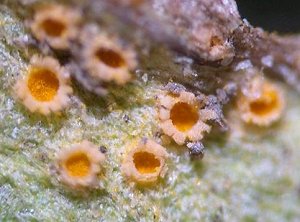
I started weeding out some of my beds on the allotment. I told you this was the time of year for rusts and moulds. I found Melampsoria euphorbiae on Sun Spurge and Puccinia lagenophorae on Groundsel. Although small, they are very attractive when examined under a low power microscope.
Wednesday 8th August 2012
At last some signs of increasing fungi on the golf course. A host of Amanita rubescens (Blusher), a couple of Amanita fulva (Tawny Grisette) and Russula atropurpurea (Purple Brittlegill) and lots of Gymnopus confluens (Clustered Toughshank). All were in the same section of woodland where my ball managed to land. I shall have to devise a plan to hit my ball into other wooded parts of the course.
Saturday 11th August 2012
After all this wet weather, I found a fungus I did not want. Phytophthora infestans (Potato Blight). So I spent most of the day digging my potatoes out before carefully checking them and bagging them. I also dug out lots of Angallis arvensis (Scarlet Pimpernel). Some of the leaves bore a small reddish spot that had rings similar to the common fungus found on cabbages, an Alternaria. There is an Alternaria angillidis that grows on Scarlet Pimpernel but there is only one record on the National database. Unfortunately, I can not find any spores to confirm it.
Monday 13th August 2012
I managed to hit my golf ball somewhere new this morning and found it nestled next to a large Inocybe rimosa (Split Fibrecap). At 12cms across this was a large specimen. Sadly it was the only fungus I found. Either they are not growing or I am playing better.
Sunday 19th August 2012
The North West Fungus Group held a microscope workshop to help the less experienced how to set up their microscopes and prepare slides. We had a very good attendance. Most of them have better microscopes than me. I shall have to invest. The main hurdles were to persuade people to prepare very tiny sections of fungus and then not to drown them, as I did when I first started. We did a short foray round Risley Moss to collect specimens for study. Most interesting under the microscope were cystidia from Macrocystidia cucumis (Cucumber Cap) which are very pointed and unmistakeable. Another interesting find was of Paecilomyces farinosus that grows from buried moth pupae.
Monday 20th August 2012
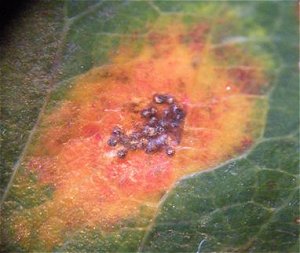
One of my colleagues has a particular interest in rusts. In our recent circular of mycological notes, particular reference was made to Gymnosporangium sabinae, a rust that affects the leaves on pear trees. In the past, I have noticed it on one or two leaves. I popped up to the allotment tonight and discovered that my pear tree was covered with it. The pears are not very good this year but whether that is because of rust or the frost in May, I know not.
Tuesday 21st August 2012

An interesting day dodging the heavy showers again. This morning, after an hour of digging my allotment, I popped into the local golf course across the road. Under the pines I found Xerocomus chrysenteron (Red Cracking Bolete). This was once the most common Xerocomus but recently it has been found that it has been often mistaken for other species and is mainly found under pine. In the afternoon after hours of torrential rain, I took a quick walk round another nearby park. Under a Beech I found another Xerocomus, this time X. pruinatus (Matt Bolete). Interestingly it has small red dots in the base of the stem which helps with the identification.
Wednesday 22nd August 2012
Golf no rain but not much around. The first Leccinum durisculum of the year. This is only found under Aspen so I am fortunate in having a couple of small copses of this tree. I understand that the plan is to remove them all. No more LDs.
Friday 24th August 2012
Played golf today. Not much around. The odd Russula ochroleuca (Ochre Brittlegill) and the Polyporus squamosus (Dryad's Saddle) had returned despite the action of the mowers.The only new species was Lepiota cristata (Stinking Dapperling). An unfortunate name because it is not that bad a smell.
Monday 27thy August 2012
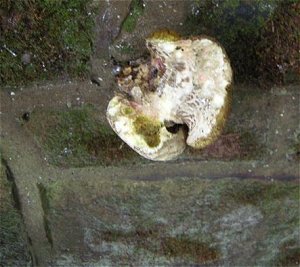
More heavy rain. I was going to a music festival but it was cancelled so I took advantage of a quiet spell for a walk around my local park. Things are starting to move. A number of Russulas (Brittlegills) under the pines. Also a brown Inocybe which, because of it's marginate-bulbous stem (with a ledge) and the large tubercles (bumps) on the spores, I have decided is Inocybe napipes (Bulbous Fibrecap), not common under pine. An unusual find was of Xerocomus porosporus (Sepia Bolete) growing from a crack in a stone wall, three feet from the ground. The mycelium must have gone up instead of down (not my best photo effort).
Tuesday 28th August 2012
Pruning out my blackberry bush today. Oh joy. Hypholoma tuberosum has appeared again in the next plot. That makes four years in a row. It still has not moved from this small vegetable bed. I would love to know what is so different about this very small piece of land that attracts this species. Why has it not moved?
Wednesday 29th August 2012
As I am leading a foray on Sunday, I visited the site at Carr Mill Dam, to check on parking and underfoot conditions. I am pleased I put my wellington boots on as it was very wet and muddy. I then had to shelter under a railway bridge for half an hour to shelter from a severe thunderstorm. By the time I left, it was much wetter and muddier. I came home to finalise the finds from the previous days. One turned out to be Agrocybe putaminum, a recent arrival to this country, growing on woodchip. It has no ring and the cystidia are different from the more common Agrocybes. I am sure I found it earlier in the year but I could not find one in good condition to prove it. They all had some sort of mould. These ones were fine.
Thursday 30th August 2012
This morning I returned to a site I looked at earlier to check if there was an Oak tree to confirm my identification of a Xerocomus. There was not, so I shall have to look at it again. On a venerable Yew tree I found a large patch of Nectria. A check of the National Database does not reveal many finds of a Nectria on Yew. Another which needs careful research. I also came across a large patch of Lyophyllum connatum (White Domecap), in the same place as last year.
